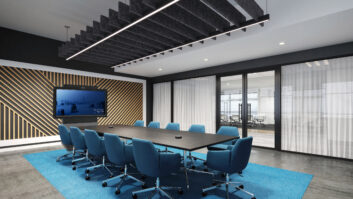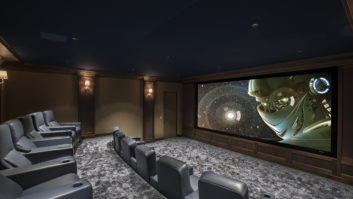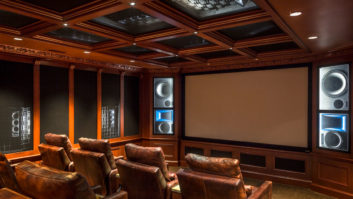At last year’s CEDIA EXPO Ron Salb, configuration manager and theater designer for Cutting Edge Systems in Acton, Massachusetts, taught a course titled, “Working Effectively with a Custom Cabinet Maker.” The class offered lessons on how to manage projects that deal with highly detailed custom cabinetry. Salb took a moment, recently, to explain a few of the finer points of the subject and to preview what attendees can expect this Fall.
Jeremy Glowacki: What kind of experience with millwork contractors do you bring to the courses that you teach for CEDIA?
Ron Salb: Well, I’m dealing with it on a day-to-day basis. I’m doing the documentation, including the CAD work, behind a lot of the designs we do at Cutting Edge Systems. I’m constantly dealing with the trades-millwork contractors, specifically-and integrating our equipment into their designs. That’s a big focus of what I do here, so it’s just a natural thing for me to be able to teach something about it; it’s what I’m living and breathing. I pretty much cover the mechanical side of things-the ventilation issues, the electrical requirements, weight requirements and structural requirements to hold the equipment, whether it is plasmas or projectors or things like that.
Describe your business experience a little bit.
I have a design background and an electro-mechanical background. So between the two of them, they seem to fit pretty well.
When we use the term “millwork contractor,” what are really talking about? Define the scope of “millwork.”
If it’s a theater, then it’s a full room. Basically the millwork is the trim in between acoustic paneling. It’s the cabinets that hold the speakers. It’s the stair-step risers under the seating. Sometimes it’s just a built-in cabinet for audio/video. If you were doing a surround system, you would typically have in-wall speakers installed in the sheetrock. That would not involve the millwork contractor. He would just be involved with the bookshelf speakers and the racks for the equipment.
How would you characterize the professionalism of your typical millwork contractor?
They vary quite a bit. Sometimes I get great plans (drawings) from them and have an architect and interior designer involved. When that happens you have a really good end result for the products you install. If you have a lot of professionals involved that know what they’re doing, obviously your product is going to shine. But I also have the case where there are no drawings from anybody but me, so I’m the one who ends up coming up with the layout of where the speakers and equipment go in a cabinet. You’re giving the general layout, and then they take that and build their cabinet. Depending on the level of sophistication of the millwork contractor, they may or may not have drawings. I’ve worked with guys who build with sketches. They meet with the client, sketch out what they’re looking for and they build from that. I’ll give them what I can. For us, I try to come up with cutsheets so I can give them as much information, quickly, without having to do a custom drawing every single time when there’s a cabinet involved. I come up with cutsheets for the racks and specific speakers that we carry.
So you would meet, initially, and they would give you an idea of what they want to create and you can then say, ‘this is the size of speaker that would work with that,’ etc.?”
Typically the salesperson meets with the clients. He’ll sell a certain thing, and it’s my job to try and get that to fit. If it doesn’t fit, then obviously I have to go back to the salesperson and convince him to sell the customer something that will work with the design. About 80 percent of the time we get the stuff that’s spec’d in the sales proposal to fit. When you do have a change, we have a change order process that we must go through.
So that ties right into your CEDIA course becoming more a part of the project management curriculum, doesn’t it?
Yes, and this year they’re changing those courses to the PMI (Project Management Institute) model. I’m going to restructure my course into the stages that they recommend. The content of the course will still contain more detail in terms of behind-the-scenes work. When I taught it last year, the class wasn’t structured in such a way that you would call it a “project management model.” It talked about the same information, but now it follows the patterns that PMI has established. I’m still going to talk about ventilation, unique mounting situations for plasma, projectors and screens, what safety issues to look for, etc., because I think that’s something that’s often overlooked in our business.
Could you be more specific about the safety issues that sometimes are overlooked?
I’m CEDIA Designer 1-certified, and CEDIA specifies that your support mechanism must support five times the weight of the equipment that you’re hanging. So if you’re mounting something that’s 100 pounds, then that wall, that ceiling joist or that area that you’re mounting to, needs to support 500 pounds. That’s not something everybody realizes, and it’s also something you need to make the millwork contractor or builder aware of. There are plenty of architects, builders and contractors who are fully aware of this, but in our industry we need to be aware of it and be able to pass that information along in case they don’t know.
What about ventilation? What do you face as far as hurdles in that regard?
That’s huge right now for A/V cabinets. For theaters it’s pretty well known that you’re going to have a lot of heat, because you have a ton of amplifiers to power that whole theater set up. But even when you get into small audio/video media systems, you have a receiver, a satellite receiver, TiVos, etc. They all get extremely hot. I always specify ventilation at the top and the bottom of the cabinet. You want to get cool air to come into the cabinet from the room and then exhaust it out the top or out the side of the cabinet. We do use fans, of course, to keep that flow going. We’re looking at other ways of doing it, too. How can we get the air out of the cabinet completely? Can we vent it into a crawlspace? Can we vent it outside of a room? For theaters I’ve talked to builders about getting dedicated HVAC zones, but I haven’t gotten that to happen yet. Even if they were to provide a dedicated ductwork for that projector, the problem is that you have heat and air conditioning through the same ductwork. So if you close the damper, there’s a concern that heat is still getting by, and eventually that duct is actually going to end up heating up the equipment.
In coordinating the efforts of the millwork contractors, interior designers and architects, how do you feel that the custom integrator fits into that whole mix and how much direction are you and your crew giving these folks?
I try to tell people that we should get involved in the project as soon as possible. The earlier that we’re involved in the planning stage of the system or the room, the better. It’s a catch-22, because I’ve been a situation where I’m asking an interior designer for plans and they’re asking me for specs. Ideally I’d rather have their plans, because I can see things that they won’t see in planning it out. I direct some of the fit and finish based on the requirements of the system and based on my experience. When I give them specs ahead of time, it’s usually going to come back to me, and I’m going to have to rework it.
When it comes to the types of materials that the millwork contractor chooses, how much “say” does the integrator have? For instance you’d probably prefer to avoid too many reflective surfaces in a room.
You can only influence so much. In the end, it’s a room that the client is going to live in or use and it’s visual as well as auditory.
How integral is the role of the millwork contractor in creating the architecturally beautiful room that helps you blend in your technology installation?
Years ago you had this rack of gear up on the left or right side. Now everybody wants to hide the stuff away. They don’t want to see what’s going on behind the scenes. You just want to enjoy the movie and be in a nice relaxed atmosphere.
Are you generally finding that millwork contractors are becoming more familiar with the idea of home theater?
Yes, they are becoming more aware of it. We have one company in particular who’s looking to partner with us and do cabinets that are standardized to typical systems setups from us. He’s already aware of issues such as ventilation and space requirements. So, yes there are cabinetmakers around who certainly understand it. There are also ones that don’t, but are still very good to work with. You just help them through a project, in those cases, and it usually works out very well.
How much do you have to manage new product lines that will affect standard cabinet dimensions?
That’s something that requires a bit of foresight. When we specify racks, we always try to allow extra space-extra blanks, extra vents in the rack. That way we always have space to upgrade, when a new music server comes out or a DVD recorder. We try to keep up with what might be added to the rack. As far as mounting plasmas, I try to use brackets that are universal, so it’s not specific to just one television design. Then if the client changes models in five years, the bracket will still work. If you do your engineering ahead of time, you specify mounting plates and brackets that are fairly universal.
You mentioned that you serve a very dedicated role working with the various subs on a project. What advice would you give to other integration firms about having someone on staff in your role?
We’re lucky enough that we can do it this way. We even went the next step by hiring a project coordinator to track scheduling between the millwork contractor and me. It will allow me to do more of the engineering ahead of time instead of doing it out in the field. I think that most custom installation companies have fewer resources than we do, so I recommend that their lead technician be the person who should be the main contact with the millwork contractor. One of the things I stressed in my class was that project management doesn’t have to be done on Microsoft Project or another software. It just needs to be good communication that gets across to the right people. Create a sketch that provides a cutsheet for a particular product, even if it’s hand-drawn. As long as you can get the idea across of what you’re trying to provide and what needs to be done, that should be adequate.






